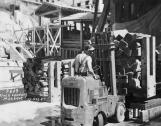23
This pile of blocks represents one day's supply of groundwood for the eight newsprint machines in operation in the 1950's at the Powell River mill.24
One days supplyCirca 1950
Powell River, British Columbia, Canada
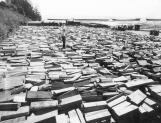 Credits:
Credits:P01673
Catalyst Paper, Powell River Division
25
Gerlinger Carriers were often seen buzzing about the mill and up the hill from the woodroom area. They were used to transport blocks from the block loaders in the wood mill to the grinder rooms. In the background are wood stave tanks used to store ground wood pulp from the grinder rooms.26
Gerlinger CarrierCirca 1940
Powell River, British Columbia, Canada
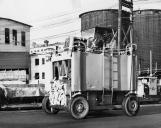 Credits:
Credits:P01636
Catalyst Paper, Powell River Division
27
A specialized jeep known as a Fork Lift was used to pick up individual skips loaded with wood blocks destined for the grinder rooms at the Powell River mill.29
Although this picture is titled Grinder Wheel--P.R.P.M. it is a water turbine or "water wheel" located in the grinder room. The front control standard would today be replaced by electronics undreamed of by the tradesmen of 1913.30
1913 Grinder WheelCirca 1913
Powell River, British Columbia, Canada
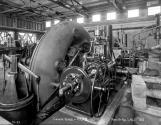 Credits:
Credits:P01059
Rod LeMay, photographer
31
An interview with a groundwood employee.The Jiggerman is responsible for the production of your department in eight hours. They have to jig the grind if they need; they have to put people in a system where they'll work; and report any broken things, report anything which is unsafe It's just the head man on the crew. He's just watching around.
It was pretty tough. You have to use your muscle that's all.
When I started work I applied to go work in the millwright maintenance crew. But then I went Jiggerman - I went off the grinder. But if I [had still been] on the grinder, maybe I would have searched outside [for another position]. But then when you get to be Jiggerman, you just watch men and you get a little responsibility. You have to fight with the men sometimes. It's pretty hard to satisfy so many people. It was ok with me. I got along pretty well with the young people, with old people, with anyone. I was satisfied with my job. And all the students, when they come work in the grinder room, they say 'we want to go work of (my) shift.
Interview tape
People of the White City
32
A back breaking jobCirca 1950
Powell River, British Columbia, Canada
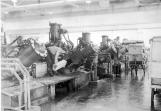 Credits:
Credits:P10579
Catalyst Paper, Powell River Division
33
....now the crews in the Grinder Rooms have ground the logs into pulp, let's see what the next operation entails. It can readily be understood that the fibres, and that is all a log constitutes, could not make newsprint if they were used in the same condition as they are sent from the grinders, so we put them through a washing process to remove the acid that has been used to clean the pulp stock, and after, through a number of screens to remove slivers, chives and small pieces of wood. From the time the pulp enters the third floor of the washer building till it falls in the decker tanks, it is gravity fed--that is, it falls from one operation to the next.When the pulp stock enters the stock washer plant it flows into four large Oliver, 60 mesh wire filters and the bleaching acid is removed by a vacuum principle. Immediately fresh water is drawn through the stock and the washing process is complete.
The fibres are now white and clean, but very course, so now by gravity the stock flows to the knotters, white water being added at the same time to dilute the stock for screening purposes. The Knotter screens are slowly revolving cylinders with plates using 1/4 inch holes which allow the good stock to pass through, leaving the small pieces of wood and long slivers that flow to the Jeffries shredder. The accepted stock from the Knotter screens has now passed to the First Quiller screens, which is a fast turning sieve. The holes are only 0.70 inch. It is through these machines that the good stock flows on its way to the deckers and the rejects are conveyed to a series of five, second screens, with .065 plates.
The good fibres from these machines also flow to the deckers while the rejects are again conveyed to two coarse screens fitted with 0.120 screen plates, from which the rejects go to the Jeffries shredder and the accepted pulp is pumped through yet another screen. The finer fibres from this machine flow to the deckers while the rejects go to the Bauer refiner in the old screen room and to a Hoag in the new mill.
If there should be more coarse pulp or slivers than the refiners can accommodate, the wet machines and press are brought into use to convert the pulp into laps or bales to be used later for wrapper stock--soft heads, roofing papers or beer bottle wrappers.
Particular attention must be paid by the screen tenders--every 15 minutes they test the screens by dipping a small sieve into the stock as it rushes from the screens. By holding it to the light they can see if any large fibres are passing, thereby denoting a broken screen plate.
Rex Needham
Men and Paper
Dec. 21, 1946
34
Ground Wood Stock Washers25 September 1948
Powell River, British Columbia, Canada
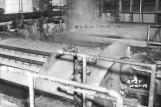 Credits:
Credits:A13-5-3
Catalyst Paper, Powell River Division
35
The accepted stock is now clean and free from slivers but during the refining process a huge quantity of water has been added, so the next item on the program is to dewater the pulp. Here the decker is used, this being made up of a large vat into which the pulp flows while a revolving cylinder covered with Fourdrinier wire picks up the fibres and transfers them to a couch roll turning on the top.The pulp is scraped off the couch roll by a doctor board and falls into a tank while the white water flows away to another channel, finally to be pumped away to be used and as a means of adding water to dilute the new supply of pulp arriving from the stock washer.
The consistency of the pulp under the deckers is now purely guess work so a more precise method must be used. As the stock is pumped from the decker tanks to the large storage tanks, the hydraulic regulators go to work and either add water or shut it off automatically.
The final operation down in the screen room is to pump the pulp to the beater rooms. Down in the basement is a battery of pumps that draw the stock from the three huge wood stave tanks, each with a capacity of 60 tons of the finest, cleanest groundwood pulp, made by an equally swell bunch of fellows.
Rex Needham
Men and Paper
Dec. 21, 1946
36
Groundwood deckers20 October 1955
Powell River, British Columbia, Canada
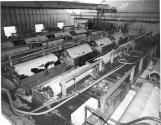 Credits:
Credits:PC-GW3
R.F. Metcalf, photographer
Dave Buchanan
